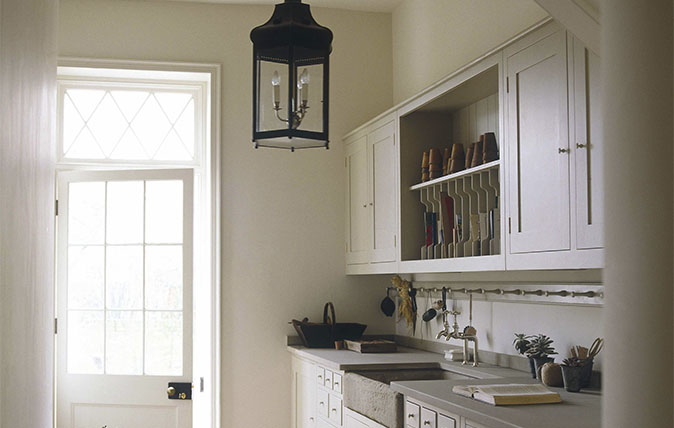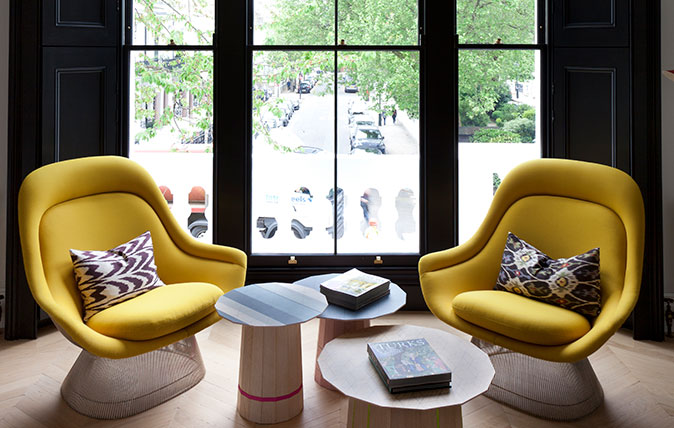Kitchen designer Tom Howley gives advice on how to maximise style with minimum space.
What’s the best way to plan the space?
My goal is to create a balanced design with pleasing symmetry where possible and cabinetry scaled to suit the space. Start by reviewing the room as a whole and consider how you plan to use it: where will you prepare food, eat breakfast or enjoy a drink with a friend?
Have you got a range cooker or smart wine cabinet in mind? Would you like everything hidden away or do you prefer to have items on display? Do you favour linear or curved shapes? A wish list will help get discussions with a kitchen designer off to a flying start.
What are the best layout options?
If you take a ‘typical’ galley kitchen to be 12ft long by 6ft wide, an island or peninsula is unlikely to be an option because there’s insufficient space. A kitchen needs to be as functional as it is beautiful, so sacrificing precious floor space to an island will only result in an awkward layout.
However, if you have a little more width to play with, then a slender island can be an excellent addition and make a good way of bridging the two sides of the room. Always leave 3ft of space between two runs of cabinetry to make sure you can move comfortably between them.
What are the best colours and materials to use?
Lighter wood finishes and paint colours work well to expand the sense of space. Whites and creams give a classic look and a smoky-grey scheme, such as a smoked oakwood paired with a matte-grey paint, offers an update. Twin these tones with light-coloured countertops for an airy look.
Mirror and glass, in splashbacks or wall cupboards with glazed panels, can be used to reflect light to create an illusion of more space. Consider the different effects that can be achieved by using varied wood grains on cabinets: low-ceilinged rooms can be given a loftier look with a vertical grain pattern, but a horizontal one can emphasise the low-level cosiness of a room.

How can storage be maximised?
Tall units offer the most storage, of course, but they tend to work best in rooms with lofty ceilings and more space than a very compact kitchen. If the cabinetry stops short of the ceiling, it can create the illusion of more width to the room. In smaller kitchens, waist-height units with pull-out shelving are the best option and make it easy to view the contents. This arrangement also ‘opens up’ the space at head height, to create a more roomy feel and prevent the space feeling crowded.
Any space-saving tips?
At the entrance to the kitchen, fit sliding doors, preferably those that slot into side ‘pockets’ in the wall, in order to maximise space. Within the kitchen, the golden rule is to use pull-outs, which make for much more effective and easy-to-use storage than cupboards, as you need fewer of them to store the same amount of equipment and food.
Consider every inch of space: some sinks come with a fitted cover that works as
a chopping board, for example. Built-under appliances, such as wine cabinets and fridges, will ensure you don’t have to sacrifice work surface. Hobs with integrated extraction free up space above for a beautiful splashback or painting.
Is it possible for compact to be chic?
Definitely! Avoid fussy detail and keep it simple, balanced and classic for elegant results that will stand the test of time.
Find out more about Tom and see his exquisite bespoke kitchens at www.tomhowley.co.uk

The dos and don’ts of designing your own ideal utility room
From stone sinks to sturdy, Merlin Wright of Plain English offers advice on creating the perfect utility room.

How, and why, to decorate your house with black paint
Interior designer Suzy Hoodless reveals the secret to using black paint.

Interior design: The designer’s room
Country Life gets the Emma Sims-Hildtich look




